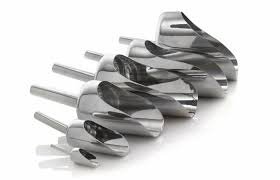Different Types of Stainless Steel for Pharmaceuticals

🔹 Types of Stainless Steel in Pharmaceuticals
1. SS 304 / 304L (AISI 304)
-
Composition: 18% Cr, 8% Ni
-
304L = low carbon version → better weldability, less sensitization
-
Applications:
-
Non-contact parts (frames, supports, furniture, piping for non-critical utilities)
-
Storage tanks for non-corrosive materials
-
Equipment housings, cleanroom furniture
-
-
Limitations: Susceptible to chloride stress corrosion (pitting, crevice corrosion).
2. SS 316 / 316L (AISI 316)
-
Composition: 16–18% Cr, 10–14% Ni, 2–3% Mo
-
316L = low carbon → superior resistance to corrosion after welding
-
Applications:
-
Contact parts of manufacturing equipment (reactors, blenders, coating pans, fluid bed dryers)
-
Water systems (PW, WFI, clean steam lines)
-
Pipelines, tanks, filling machines
-
-
Reason: Molybdenum improves resistance to chlorides and chemical attack.
-
Industry Standard: Most common for pharma contact surfaces.
3. SS 904L
-
Composition: High Ni (~23–28%), Mo (~4–5%), Cu addition
-
Applications:
-
Highly corrosive environments (high chloride content, aggressive acids)
-
WFI distribution systems in tropical/high humidity regions
-
Used where 316L is inadequate
-
-
Limitations: Expensive, more difficult to machine/weld.
4. Duplex Stainless Steels (e.g., 2205, 2507)
-
Microstructure: Mix of austenite + ferrite
-
Strength: Higher mechanical strength, better stress corrosion resistance than 316L
-
Applications:
-
Some pharma water systems where high chloride levels are expected
-
Special cases where strong resistance to cracking and higher strength is required
-
-
Limitations: Less common in pharma due to fabrication difficulties.
5. Other Special Grades
-
SS 317L: Higher Mo than 316L; used rarely for stronger chemical resistance
-
SS 410 / 420 (Martensitic): High hardness → used for scissors, blades, surgical instruments
-
SS 440: Very hard, used for surgical cutting tools
-
SS 321 / 347: Stabilized with Ti/Nb; used in high-temperature applications (steam systems, heat exchangers)
🔹 Key Selection Considerations in Pharma
-
Product contact vs non-contact: Use 316L for contact parts, 304L/other grades for non-contact.
-
Corrosion resistance: Select higher grades (904L, Duplex) if chloride-rich or aggressive environment.
-
Weldability & surface finish: Must allow electropolishing, passivation, and smooth Ra ≤ 0.4 µm for hygienic design.
-
Regulatory compliance: Must meet ASME BPE, ASTM, and GMP requirements.
✅ Summary Table
| Grade | Composition Key | Corrosion Resistance | Common Pharma Use |
|---|---|---|---|
| 304 / 304L | 18% Cr, 8% Ni | Moderate | Furniture, non-contact parts |
| 316 / 316L | +2% Mo | High (chlorides, acids) | Contact parts, water systems |
| 317L | Higher Mo | Higher than 316L | Rare, special chemicals |
| 904L | High Ni, Mo, Cu | Very High | WFI systems, aggressive chemicals |
| Duplex (2205, 2507) | Cr + Ni + Mo (balanced) | Very High | Special high chloride utilities |
| 410, 420, 440 | High C, Cr | Hard, lower corrosion | Surgical instruments |
| 321, 347 | Ti/Nb stabilized | Heat resistant | Steam/heat exchangers |
🎓 Discover one of the best Complete Pharmaceutical Production Course available —click below to explore the course that’s shaping future Production Course skills.
https://trcjw.on-app.in/app/oc/338669/trcjw

